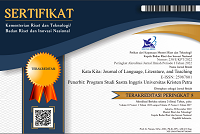Obsessive Love Turns to Violence: A Textual Analysis in Edwin’s Posesif
(1) Petra Christian University
(*) Corresponding Author
Abstract
Relationship violence refers to any attempt to control or dominate another person physically, sexually, or psychologically, causing some level of harm (Wekerle & Wolfe, 1999). According to the Ministry of Female Empowerment and Child Protection of the Republic of Indonesia, almost half of the perpetrators are boyfriends or friends. This concerning phenomenon is what Edwin, Posesif’s director, tries to portray in his film. He represents this reality as a means to raise awareness of obsessive love that turns to violence among teenagers, who just left their childhood and are going to a romantic relationship by seeing the signs of such a relationship. However, without proper understanding on why the characters in this movie are involved in violence relationships, it will not be easy for the audience to learn from the movie. We need to acknowledge the characters’ background and purposes in the romantic relationship to reveal why they are trapped in relationship violence. Therefore, the question is why obsessive love happened to them. Why is the male character, Yudhis, obsessed with Lala, the female character, and why does Lala not end her relationship despite what has happened to her? Bandura’s social learning theory and Bowlby’s attachment theory are used as a framework to unfold their background and behaviors. Both theories include the role of caregivers to the young ones that set templates in their behaviors’ responses in life. In this study, it is known that Diana, Yudhis’s mother, and Lala’s father are both failed in giving adequate attention to their children that causes Yudhis and Lala trapped in a co-obsessive relationship, putting Yudhis as the perpetrator and Lala as the victim. By understanding this, this film can encourage adults and teenagers to be aware of obsessive love and prevent violence in any relationship.
Keywords
Full Text:
PDFReferences
Daftar Film Indonesia Tahun 2017. (2021). Wikipedia: Ensiklopedia Bebas. https://id.wikipedia.org/wiki/Daftar_film_Indonesia_tahun_2017
Forward, S., & Buck, C. (1991). Obsessive Love: When It Hurts Too Much to Let Go. Bantam Books.
Heeren van, K. (2012). Contemporary Indonesian Film; Spirits of Reform and ghosts from the past. In Contemporary Indonesian Film; Spirits of Reform and ghosts from the past. KITLV Press. https://doi.org/10.26530/oapen_420331
Noer, G. S. (n.d.). Posesif (2017) - Full Transcript. Subslikescript. Retrieved June 18, 2021, from https://subslikescript.com/movie/Posesif-7541708
Smith, P. H., White, J. W., & Holland, L. J. (2003). A Longitudinal Perspective on Dating Violence among Adolescent and College-Age Women. American Journal of Public Health, 93(7), 1104–1109. https://doi.org/10.2105/AJPH.93.7.1104
Waspada Bahaya Kekerasan dalam Pacaran. (2018). Kementerian Pemberdayaan Perempuan Dan Perlindungan Anak Republik Indonesia. https://www.kemenpppa.go.id/index.php/page/read/31/1669/waspada-bahaya-kekerasan-dalam-pacaran
Wekerle, C., & Wolfe, D. A. (1999). Dating Violence in Mid-Adolescence: Theory , Significance , and Emerging Prevention Initiatives. 19(4), 435–456.
DOI: https://doi.org/10.9744/katakita.11.2.177-186
Refbacks
- There are currently no refbacks.
Supported by:
Indexed in:
Tools:
Stats (installed since 17 December 2018)
View My Stats













